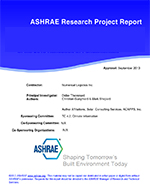Description
Duct rumble noise is commonly attributed to the poor aerodynamic discharge conditions of fan outlets. Thus far, qualitative descriptors have been used as guidelines for engineers to limit the amount of duct rumble noise. The objective of this study was to create and verify a test facility that would accurately quantify the amount of duct rumble noise that was caused by the change in discharge conditions of a fan and duct system. Valid data will then be used to replace the qualitative descriptor with quantitative predictions. A key design constraint of the testing system was detecting the change in sound due to the fan discharge configuration.
The test facility was capable of changing between fourteen different discharge conditions. There were four different fan orientations: a fan in front blast condition blowing directly into the duct work, a fan in upblast with rotation towards the elbow, a fan in upblast rotating with the elbow, and a fan upblast rotating against the elbow. Each of these was measured with the fan outlet at different distances away from the duct inlet. The “optimum” or frontblast had two distances between the fan and inlet, the rest of the orientations had four distances between the fan and the inlet. The fan was operated at eight operating points distributed over the fan operating range. The duct and measurement system was designed to easily measure and verify the sound pressure level effect of the fan discharge conditions.
The sound measurements were taken at one-third octave bands between 16 and 300 Hz. The narrow band analysis was taken up to 800 Hz. The measurements were taken in an acoustically isolated room at nine locations in the room and seven locations in the ductwork. The accuracy of the measurement was within ± 1dB, which was far less than the 3 to 11 dB variations that are caused by the fan configuration.
The results were analyzed with the goal to develop mathematical relationships based on the data that could be used to estimate the change in sound power as a function of flow rate, pressure drop across the fan, fan orientation, distance of the fan outlet to the elbow transition, and frequency. The results show that the dependence is more complex than a multi-variable polynomial model. Taken together, all the results suggest that future work is needed for more detailed analysis of the inlet and outlet flow conditions of the fan.
Units: I-P
Product Details
- Published:
- 2007
- Number of Pages:
- 169
- File Size:
- 1 file , 3.1 MB
- Product Code(s):
- D-RP-1219




